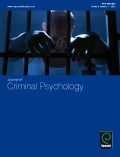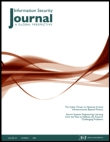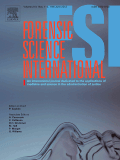
International Journal of Digital Crime and Forensics
Scope & Guideline
Unveiling Insights into Cybersecurity and Forensic Practices
Introduction
Aims and Scopes
- Digital Forensics Techniques:
The journal emphasizes innovative methodologies in digital forensics, including the development of new tools and techniques for evidence collection, analysis, and interpretation in various digital environments. - Cybersecurity and Information Assurance:
Research focusing on the protection of digital information and systems from cyber threats is a core area, highlighting strategies for securing data and maintaining privacy in digital communications. - Machine Learning and Artificial Intelligence Applications:
The application of machine learning and AI in enhancing forensic processes and cybersecurity measures is prominently featured, showcasing how these technologies can improve detection, analysis, and prediction of criminal behavior. - Emerging Technologies in Forensics:
The journal explores the implications of new technologies, such as IoT, UAVs, and edge computing, on forensic practices, addressing how these tools can be leveraged for criminal investigations. - Behavioral Analysis and Threat Detection:
Research related to understanding user behavior and identifying abnormal activities in digital environments is a significant focus, contributing to the development of proactive security measures.
Trending and Emerging
- Integration of Machine Learning in Forensics:
There is a significant increase in research that applies machine learning algorithms to forensic analysis, enhancing the ability to detect anomalies and automate evidence analysis. - Edge Computing in Forensic Applications:
Recent publications have explored the role of edge computing in digital forensics, particularly in relation to mobile and vehicular networks, reflecting a trend towards decentralized data processing. - Cyber-Physical Systems and Forensics:
The intersection of cyber-physical systems with forensic practices is gaining traction, as researchers investigate how to secure and analyze data from interconnected devices. - Video and Image Forensics:
An increasing number of studies focus on video and image forensics, specifically in the areas of deepfake detection and tampering analysis, highlighting the importance of visual data integrity. - Privacy-Preserving Forensic Techniques:
Emerging themes include the development of privacy-preserving frameworks that ensure the security and confidentiality of sensitive information during forensic investigations.
Declining or Waning
- Traditional Forensic Techniques:
There is a noticeable reduction in publications focusing on traditional forensic methods, as the field shifts towards more technologically advanced approaches that incorporate AI and machine learning. - General Cybersecurity Practices:
While cybersecurity remains a priority, the journal has seen a decrease in papers discussing generic cybersecurity measures, with a shift towards specialized applications and innovative solutions. - Static Analysis Methods:
Research centered on static analysis techniques for security and forensics has declined, likely due to the rising interest in dynamic and machine learning-based analysis methods that offer more robust solutions. - Basic Data Recovery Techniques:
The focus on conventional data recovery techniques has diminished as researchers increasingly explore more complex and advanced retrieval methods that integrate new technologies.
Similar Journals

Scandinavian Journal of Forensic Science
Pioneering research in forensic science for all.The Scandinavian Journal of Forensic Science is a premier open-access journal published by SCIENDO since 2012, dedicated to advancing the field of forensic science. With its ISSN 2353-0707, this journal provides a platform for researchers, professionals, and students to disseminate their findings on various aspects of forensic investigations, including but not limited to forensic biology, chemistry, toxicology, and crime scene analysis. The journal plays a vital role in promoting collaboration and knowledge exchange among forensic practitioners and academics, ensuring that cutting-edge research is accessible to all. As a part of the reputable SCIENDO publishing group, the Scandinavian Journal of Forensic Science upholds high standards of peer review and editorial rigor, making it an essential resource for those involved in the forensic science community. Readers can benefit from its open-access model, which fosters wide dissemination and enhances the visibility of published works, ultimately contributing to the societal impact of forensic research.

JOURNAL OF FORENSIC SCIENCES
JOURNAL OF FORENSIC SCIENCES is a premier publication dedicated to advancing the field of forensic science through high-quality research and innovation. Published by Wiley, this journal has been a reliable source of cutting-edge findings since its inception in 1961, with a continued commitment to excellence expected through 2024. With an ISSN of 0022-1198 and an E-ISSN of 1556-4029, the journal covers critical aspects of forensic medicine, including genetics, pathology, and molecular biology. Notably, it holds a Q2 ranking in Pathology and Forensic Medicine, reflecting its high impact and relevance in the field. Researchers and professionals benefit from comprehensive access to groundbreaking studies and discussions that drive advancements in forensic methodologies and technologies. While not an open access journal, its impact factor and rigorous peer-review process ensure that every article contributes significantly to the body of forensic science knowledge. Whether you are a seasoned forensic expert or an aspiring student, the JOURNAL OF FORENSIC SCIENCES serves as an essential resource for cutting-edge research and discoveries.

Journal of Criminal Psychology
Exploring the psychological dimensions of crime and justice.Journal of Criminal Psychology, an esteemed publication by EMERALD GROUP PUBLISHING LTD, serves as a pivotal resource in the interdisciplinary study of criminal behavior through the lenses of psychology and law. Since its inception in 2011, this journal has significantly contributed to the understanding of psychological principles as they apply to crime, law enforcement, and social justice, making it a vital source for both researchers and practitioners. With a commendable ranking of Q1 in Law and Q3 in Applied and Social Psychology for 2023, the journal guarantees high-quality research findings that can influence policy and practice across these domains. Although it does not offer open access, its rigorous peer-review process ensures that every published article adheres to the highest academic standards. The Journal of Criminal Psychology not only fosters academic discourse but also drives innovation in criminal justice practices, making it essential reading for anyone dedicated to the enhancement of ethical standards in legislation and law enforcement.

Trends in Organized Crime
Advancing Knowledge on Organized Crime PhenomenaTrends in Organized Crime, published by SPRINGER, is a premier journal dedicated to the exploration and analysis of organized crime phenomena. With an impressive impact factor and ranked in the Q1 category for Law, this journal reflects the highest echelon of scholarly work, positioning itself at the forefront of legal and social sciences research. Established in 1995 and extending its impact through 2024, the journal serves as a crucial resource for academics, practitioners, and policymakers seeking to understand the complexities of organized crime and its implications on society. While not an Open Access journal, it provides robust access options for scholarly articles, making it a vital tool for those engaged in legal studies and criminology. By fostering interdisciplinary dialogues, Trends in Organized Crime aims to illuminate contemporary issues, promote innovative methodologies, and enhance the collective understanding of criminal organizations globally.

Information Security Journal
Advancing the Frontiers of Information Security.The Information Security Journal, published by Taylor & Francis Inc, is a pioneering platform dedicated to disseminating knowledge in the realms of information security, computer science applications, and information systems management. With an ISSN of 1939-3555 and an E-ISSN of 1939-3547, this journal has successfully carved its niche within the Q2 quartile of the 2023 rankings for both Computer Science Applications and Information Systems and Management, while also being recognized in Q3 for the Software category. Located in the United Kingdom, the journal has been committed to advancing research and fostering innovation from 2008 through 2024, making it an essential resource for academics and professionals alike. With a significant Scopus ranking in its fields—placing 43rd out of 148 in Decision Sciences and 271st out of 817 in Computer Science Applications—the journal stands as a vital source of interdisciplinary insights. Although it does not currently offer open access options, the quality of publications and the journal's dedication to the field ensure that it remains a compelling choice for researchers seeking to publish their findings or stay abreast of current developments in information security.

Forensic Science International Genetics Supplement Series
Advancing forensic genetics for a safer tomorrow.Forensic Science International Genetics Supplement Series, published by Elsevier Ireland Ltd, is an essential resource for professionals, researchers, and students engaged in the increasingly critical intersection of genetics and forensic science. This peer-reviewed journal, with an ISSN of 1875-1768 and E-ISSN of 1875-175X, provides a platform for disseminating innovative research findings and methodologies that enhance the application of genetic techniques in forensic investigations. The journal has gained recognition within the academic community, evidenced by its notable rankings in Pathology and Forensic Medicine as well as Genetics, placing it in Q3 and Q4 quartiles respectively in 2023. Although it operates without an open access model, its targeted converged years—spanning from 2008 to 2022—exemplify a commitment to fostering ongoing advancements in forensic genetics. Despite its positioning, the journal remains a significant contributor to public discourse, with an emphasis on the role of genetics in legal contexts and the continual evolution of forensic methodologies.

Legal Medicine
Navigating the complexities of law and medicine.Legal Medicine, ISSN 1344-6223, published by ELSEVIER IRELAND LTD, stands as a pivotal academic journal within the realms of forensic medicine and legal ethics. Operating from the Netherlands, this journal has established a strong reputation among researchers and practitioners since its inception in 1999, with the goal of advancing knowledge in the intersection of legal and medical disciplines. With a commendable Q2 categorization in both Issues, Ethics and Legal Aspects and Pathology and Forensic Medicine, it ranks among the noteworthy publications in these fields, placing it in the 51st percentile for Pathology and Forensic Medicine and 51st for Nursing-related ethical issues. The journal not only serves as a repository for innovative research and practical case studies but also emphasizes the importance of ethical considerations in medical legal scenarios. Although it does not offer Open Access options, it remains a crucial resource for professionals, researchers, and students seeking to stay informed about the latest developments that shape legal medicine. Access to its contents promises to enhance understanding and inspire advancements in both forensic science and the ethical frameworks surrounding them.

Forensic Science International
Leading the Way in Open Access Forensic ResearchForensic Science International is a premier journal published by Elsevier Ireland Ltd, dedicated to advancing the field of forensic science through interdisciplinary research and scholarship. Since its inception in 1978, this esteemed journal has provided a platform for vital research, receiving recognition in the Q1 category for both Law and Pathology and Forensic Medicine as of 2023, underscoring its significant impact in these domains. It currently ranks 54th out of 1025 journals in Social Sciences - Law and 51st out of 208 in Medicine - Pathology and Forensic Medicine, placing it in the top echelons of academic journals according to Scopus metrics. Forensic Science International transitioned to Open Access in 2019, ensuring that critical findings are widely available to the global research community and enhancing collaboration among forensic professionals. With a forward-looking scope that evolves to meet the challenges and innovations of forensic science, this journal remains a pivotal resource for researchers, practitioners, and students who are committed to the continued advancement of forensic science and its applications in legal contexts.

International Journal of Electronic Security and Digital Forensics
Pioneering research in the realms of digital security and forensics.The International Journal of Electronic Security and Digital Forensics, published by INDERSCIENCE ENTERPRISES LTD, is a leading platform for disseminating scholarly research in the realms of cybersecurity, digital forensics, and electronic security. Established with the objective of bridging the gap between theoretical advancements and practical applications, the journal spans critical areas such as network security, legal implications of digital forensics, and reliability in safety measures. With its ISSN 1751-911X and E-ISSN 1751-9128, the journal aims to provide valuable insights into emerging technologies and methodologies while maintaining high academic standards, as reflected in its diverse quartile rankings across multiple categories in 2023. Operating from the United Kingdom and catering to a global audience, the journal is committed to fostering innovative research that contributes to safer digital environments. Researchers, professionals, and students will find a wealth of information and opportunities for collaboration in this specialized field, making International Journal of Electronic Security and Digital Forensics an essential resource for advancing knowledge and practice.

Forensic Science International-Digital Investigation
Exploring the Intersection of Law and Digital InnovationForensic Science International-Digital Investigation, published by Elsevier Science Ltd, stands at the forefront of multidisciplinary research in the realm of digital forensics and forensic science. With an impressive impact factor and recognition as a Q1 journal in critical categories such as Law and Medical Laboratory Technology, it has established itself as an essential resource for researchers, practitioners, and students alike. Its open access policy promotes broad dissemination of cutting-edge findings, facilitating collaboration and innovation in this ever-evolving field. Covering topics from computer science applications to forensic medicine, it addresses the complexities of digital evidence analysis in today's technology-driven world. As it converges from 2020 to 2024, the journal reflects ongoing advancements and profound challenges faced in forensic investigations, making it a vital platform for sharing knowledge and fostering scholarly dialogue.